[English] 日本語
 Yorodumi
Yorodumi- EMDB-4160: Imidazoleglycerol-phosphate dehydratase from Saccharomyces cerevisiae -
+ Open data
Open data
- Basic information
Basic information
| Entry | Database: EMDB / ID: EMD-4160 | ||||||||||||
|---|---|---|---|---|---|---|---|---|---|---|---|---|---|
| Title | Imidazoleglycerol-phosphate dehydratase from Saccharomyces cerevisiae | ||||||||||||
 Map data Map data | Imidazoleglycerol-phosphate dehydratase | ||||||||||||
 Sample Sample |
| ||||||||||||
 Keywords Keywords | Inhibitor / histidine biosynthesis / lyase / complex | ||||||||||||
| Function / homology |  Function and homology information Function and homology informationimidazoleglycerol-phosphate dehydratase / imidazoleglycerol-phosphate dehydratase activity / L-histidine biosynthetic process / metal ion binding Similarity search - Function | ||||||||||||
| Biological species |  | ||||||||||||
| Method | single particle reconstruction / cryo EM / Resolution: 3.2 Å | ||||||||||||
 Authors Authors | Rawson S / Bisson C | ||||||||||||
| Funding support |  United Kingdom, 3 items United Kingdom, 3 items
| ||||||||||||
 Citation Citation |  Journal: Proc Natl Acad Sci U S A / Year: 2018 Journal: Proc Natl Acad Sci U S A / Year: 2018Title: Elucidating the structural basis for differing enzyme inhibitor potency by cryo-EM. Authors: Shaun Rawson / Claudine Bisson / Daniel L Hurdiss / Asif Fazal / Martin J McPhillie / Svetlana E Sedelnikova / Patrick J Baker / David W Rice / Stephen P Muench /  Abstract: Histidine biosynthesis is an essential process in plants and microorganisms, making it an attractive target for the development of herbicides and antibacterial agents. Imidazoleglycerol-phosphate ...Histidine biosynthesis is an essential process in plants and microorganisms, making it an attractive target for the development of herbicides and antibacterial agents. Imidazoleglycerol-phosphate dehydratase (IGPD), a key enzyme within this pathway, has been biochemically characterized in both (IGPD) and (IGPD). The plant enzyme, having been the focus of in-depth structural analysis as part of an inhibitor development program, has revealed details about the reaction mechanism of IGPD, whereas the yeast enzyme has proven intractable to crystallography studies. The structure-activity relationship of potent triazole-phosphonate inhibitors of IGPD has been determined in both homologs, revealing that the lead inhibitor (C348) is an order of magnitude more potent against IGPD than IGPD; however, the molecular basis of this difference has not been established. Here we have used single-particle electron microscopy (EM) to study structural differences between the and IGPD homologs, which could influence the difference in inhibitor potency. The resulting EM maps at ∼3 Å are sufficient to de novo build the protein structure and identify the inhibitor binding site, which has been validated against the crystal structure of the IGPD/C348 complex. The structure of _IGPD reveals that a 24-amino acid insertion forms an extended loop region on the enzyme surface that lies adjacent to the active site, forming interactions with the substrate/inhibitor binding loop that may influence inhibitor potency. Overall, this study provides insights into the IGPD family and demonstrates the power of using an EM approach to study inhibitor binding. | ||||||||||||
| History |
|
- Structure visualization
Structure visualization
| Movie |
 Movie viewer Movie viewer |
|---|---|
| Structure viewer | EM map:  SurfView SurfView Molmil Molmil Jmol/JSmol Jmol/JSmol |
| Supplemental images |
- Downloads & links
Downloads & links
-EMDB archive
| Map data |  emd_4160.map.gz emd_4160.map.gz | 14.9 MB |  EMDB map data format EMDB map data format | |
|---|---|---|---|---|
| Header (meta data) |  emd-4160-v30.xml emd-4160-v30.xml emd-4160.xml emd-4160.xml | 12.6 KB 12.6 KB | Display Display |  EMDB header EMDB header |
| Images |  emd_4160.png emd_4160.png | 294.8 KB | ||
| Filedesc metadata |  emd-4160.cif.gz emd-4160.cif.gz | 5.8 KB | ||
| Archive directory |  http://ftp.pdbj.org/pub/emdb/structures/EMD-4160 http://ftp.pdbj.org/pub/emdb/structures/EMD-4160 ftp://ftp.pdbj.org/pub/emdb/structures/EMD-4160 ftp://ftp.pdbj.org/pub/emdb/structures/EMD-4160 | HTTPS FTP |
-Validation report
| Summary document |  emd_4160_validation.pdf.gz emd_4160_validation.pdf.gz | 300.2 KB | Display |  EMDB validaton report EMDB validaton report |
|---|---|---|---|---|
| Full document |  emd_4160_full_validation.pdf.gz emd_4160_full_validation.pdf.gz | 299.4 KB | Display | |
| Data in XML |  emd_4160_validation.xml.gz emd_4160_validation.xml.gz | 5.7 KB | Display | |
| Arichive directory |  https://ftp.pdbj.org/pub/emdb/validation_reports/EMD-4160 https://ftp.pdbj.org/pub/emdb/validation_reports/EMD-4160 ftp://ftp.pdbj.org/pub/emdb/validation_reports/EMD-4160 ftp://ftp.pdbj.org/pub/emdb/validation_reports/EMD-4160 | HTTPS FTP |
-Related structure data
| Related structure data |  6ezmMC  3999C  6ezjC C: citing same article ( M: atomic model generated by this map |
|---|---|
| Similar structure data |
- Links
Links
| EMDB pages |  EMDB (EBI/PDBe) / EMDB (EBI/PDBe) /  EMDataResource EMDataResource |
|---|
- Map
Map
| File |  Download / File: emd_4160.map.gz / Format: CCP4 / Size: 22.2 MB / Type: IMAGE STORED AS FLOATING POINT NUMBER (4 BYTES) Download / File: emd_4160.map.gz / Format: CCP4 / Size: 22.2 MB / Type: IMAGE STORED AS FLOATING POINT NUMBER (4 BYTES) | ||||||||||||||||||||||||||||||||||||||||||||||||||||||||||||||||||||
|---|---|---|---|---|---|---|---|---|---|---|---|---|---|---|---|---|---|---|---|---|---|---|---|---|---|---|---|---|---|---|---|---|---|---|---|---|---|---|---|---|---|---|---|---|---|---|---|---|---|---|---|---|---|---|---|---|---|---|---|---|---|---|---|---|---|---|---|---|---|
| Annotation | Imidazoleglycerol-phosphate dehydratase | ||||||||||||||||||||||||||||||||||||||||||||||||||||||||||||||||||||
| Projections & slices | Image control
Images are generated by Spider. | ||||||||||||||||||||||||||||||||||||||||||||||||||||||||||||||||||||
| Voxel size | X=Y=Z: 1.065 Å | ||||||||||||||||||||||||||||||||||||||||||||||||||||||||||||||||||||
| Density |
| ||||||||||||||||||||||||||||||||||||||||||||||||||||||||||||||||||||
| Symmetry | Space group: 1 | ||||||||||||||||||||||||||||||||||||||||||||||||||||||||||||||||||||
| Details | EMDB XML:
CCP4 map header:
| ||||||||||||||||||||||||||||||||||||||||||||||||||||||||||||||||||||
-Supplemental data
- Sample components
Sample components
-Entire : Imidazoleglycerol-phosphate dehydratase (IGPD) in complex with tr...
| Entire | Name: Imidazoleglycerol-phosphate dehydratase (IGPD) in complex with triazole-phosphonate inhibitor (C384) |
|---|---|
| Components |
|
-Supramolecule #1: Imidazoleglycerol-phosphate dehydratase (IGPD) in complex with tr...
| Supramolecule | Name: Imidazoleglycerol-phosphate dehydratase (IGPD) in complex with triazole-phosphonate inhibitor (C384) type: complex / ID: 1 / Parent: 0 / Macromolecule list: #1 |
|---|---|
| Source (natural) | Organism:  |
| Molecular weight | Theoretical: 570 KDa |
-Macromolecule #1: Imidazoleglycerol-phosphate dehydratase
| Macromolecule | Name: Imidazoleglycerol-phosphate dehydratase / type: protein_or_peptide / ID: 1 / Number of copies: 24 / Enantiomer: LEVO / EC number: imidazoleglycerol-phosphate dehydratase |
|---|---|
| Source (natural) | Organism:  Strain: ATCC 204508 / S288c |
| Molecular weight | Theoretical: 23.867197 KDa |
| Recombinant expression | Organism:  |
| Sequence | String: MTEQKALVKR ITNETKIQIA ISLKGGPLAI EHSIFPEKEA EAVAEQATQS QVINVHTGIG FLDHMIHALA KHSGWSLIVE CIGDLHIDD HHTTEDCGIA LGQAFKEALG AVRGVKRFGS GFAPLDEALS RAVVDLSNRP YAVVELGLQR EKVGDLSCEM I PHFLESFA ...String: MTEQKALVKR ITNETKIQIA ISLKGGPLAI EHSIFPEKEA EAVAEQATQS QVINVHTGIG FLDHMIHALA KHSGWSLIVE CIGDLHIDD HHTTEDCGIA LGQAFKEALG AVRGVKRFGS GFAPLDEALS RAVVDLSNRP YAVVELGLQR EKVGDLSCEM I PHFLESFA EASRITLHVD CLRGKNDHHR SESAFKALAV AIREATSPNG TNDVPSTKGV LM UniProtKB: Imidazoleglycerol-phosphate dehydratase |
-Macromolecule #2: MANGANESE (II) ION
| Macromolecule | Name: MANGANESE (II) ION / type: ligand / ID: 2 / Number of copies: 48 / Formula: MN |
|---|---|
| Molecular weight | Theoretical: 54.938 Da |
-Macromolecule #3: [(2R)-2-hydroxy-3-(1H-1,2,4-triazol-1-yl)propyl]phosphonic acid
| Macromolecule | Name: [(2R)-2-hydroxy-3-(1H-1,2,4-triazol-1-yl)propyl]phosphonic acid type: ligand / ID: 3 / Number of copies: 24 / Formula: 5LD |
|---|---|
| Molecular weight | Theoretical: 207.124 Da |
| Chemical component information |  ChemComp-5LD: |
-Experimental details
-Structure determination
| Method | cryo EM |
|---|---|
 Processing Processing | single particle reconstruction |
| Aggregation state | particle |
- Sample preparation
Sample preparation
| Concentration | 0.5 mg/mL |
|---|---|
| Buffer | pH: 7.5 |
| Grid | Model: Quantifoil R2/2 / Material: COPPER / Pretreatment - Type: GLOW DISCHARGE |
| Vitrification | Cryogen name: ETHANE / Chamber humidity: 100 % / Instrument: FEI VITROBOT MARK IV |
- Electron microscopy
Electron microscopy
| Microscope | FEI TITAN KRIOS |
|---|---|
| Image recording | Film or detector model: FEI FALCON III (4k x 4k) / Detector mode: INTEGRATING / Number grids imaged: 1 / Number real images: 2827 / Average electron dose: 1.3 e/Å2 |
| Electron beam | Acceleration voltage: 300 kV / Electron source:  FIELD EMISSION GUN FIELD EMISSION GUN |
| Electron optics | Illumination mode: FLOOD BEAM / Imaging mode: BRIGHT FIELD |
| Sample stage | Specimen holder model: FEI TITAN KRIOS AUTOGRID HOLDER / Cooling holder cryogen: NITROGEN |
| Experimental equipment |  Model: Titan Krios / Image courtesy: FEI Company |
 Movie
Movie Controller
Controller




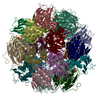

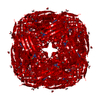
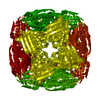
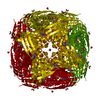
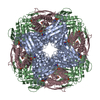
 Z (Sec.)
Z (Sec.) Y (Row.)
Y (Row.) X (Col.)
X (Col.)





















